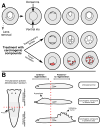Regeneration: The origin of cancer or a possible cure?
- PMID: 19427247
- PMCID: PMC2706275
- DOI: 10.1016/j.semcdb.2009.04.005
Regeneration: The origin of cancer or a possible cure?
Abstract
A better understanding of the forces controlling cell growth will be essential for developing effective therapies in regenerative medicine and cancer. Historically, the literature has linked cancer and tissue regeneration-proposing regeneration as both the source of cancer and a method to inhibit tumorigenesis. This review discusses two powerful regeneration models, the vertebrate urodele amphibians and invertebrate planarians, in light of cancer regulation. Urodele limb and eye lens regeneration is described, as well as the planarian's emergence as a molecular and genetic model system in which recent insights begin to molecularly dissect cancer and regeneration in adult tissues.
Figures



Comment in
-
Regeneration: Recent advances, major puzzles, and biomedical opportunities.Semin Cell Dev Biol. 2009 Jul;20(5):515-6. doi: 10.1016/j.semcdb.2009.04.011. Epub 2009 May 3. Semin Cell Dev Biol. 2009. PMID: 19398032 No abstract available.
References
-
- Waddington C. Cancer and the theory of organisers. Nature. 1935;135:6006–608.
-
- Slack JM. Conrad Hal Waddington: the last Renaissance biologist? Nat Rev Genet. 2002;3:889–95. - PubMed
-
- Morgan TH. Regeneration. The Macmillan Company; New York: 1901.
-
- Brockes JP, Kumar A. Comparative aspects of animal regeneration. Annu Rev Cell Dev Biol. 2008;24:525–49. - PubMed
-
- Odelberg SJ. Inducing cellular dedifferentiation: a potential method for enhancing endogenous regeneration in mammals. Semin Cell Dev Biol. 2002;13:335–43. - PubMed
Publication types
MeSH terms
Grants and funding
LinkOut - more resources
Full Text Sources
Other Literature Sources

